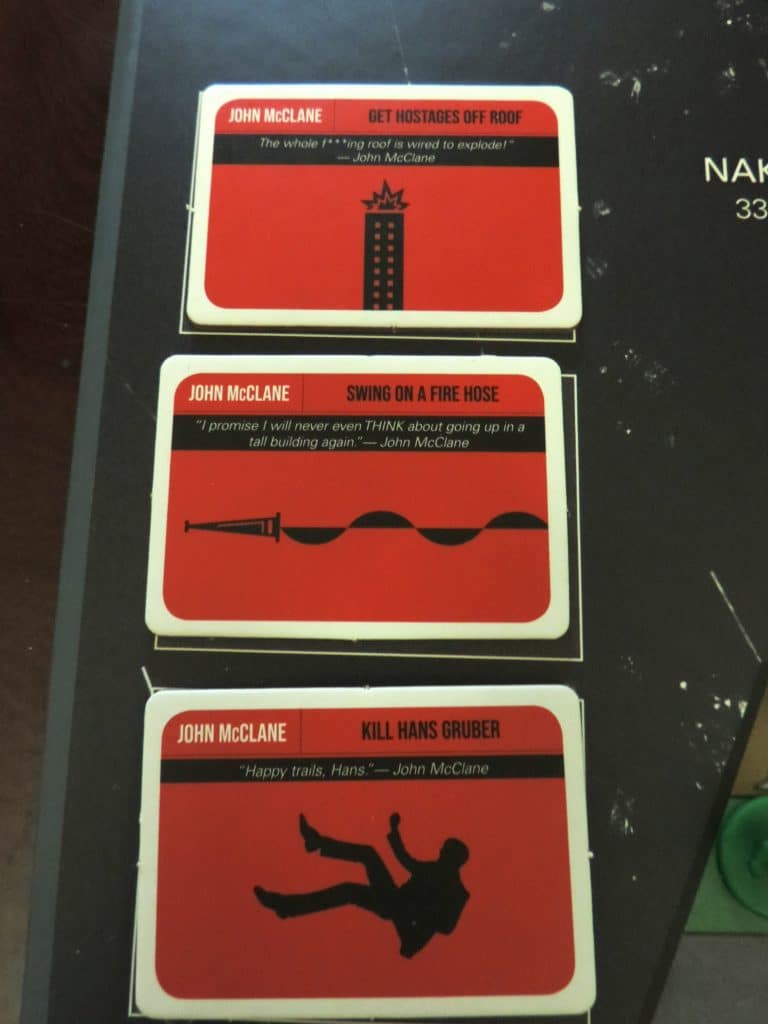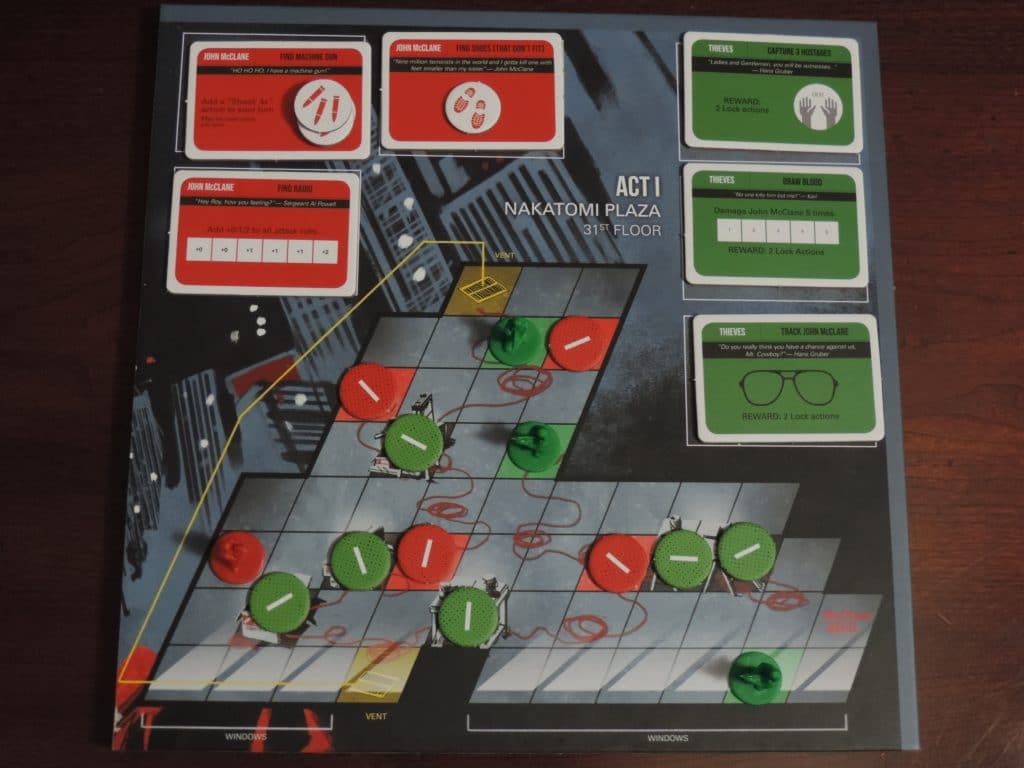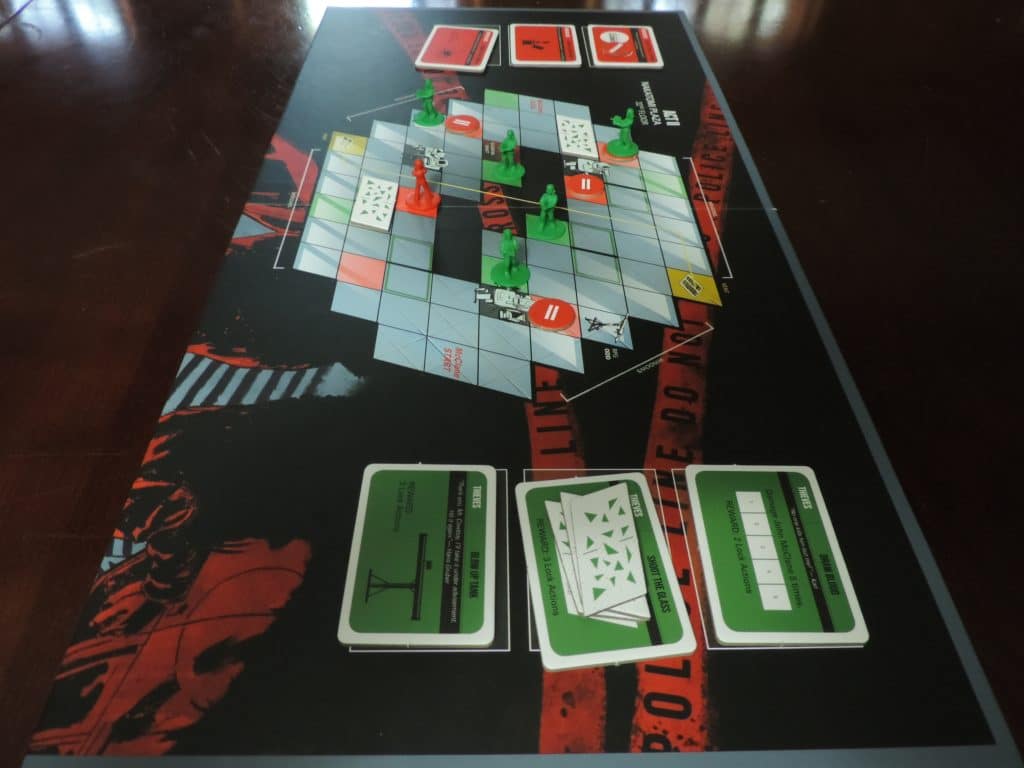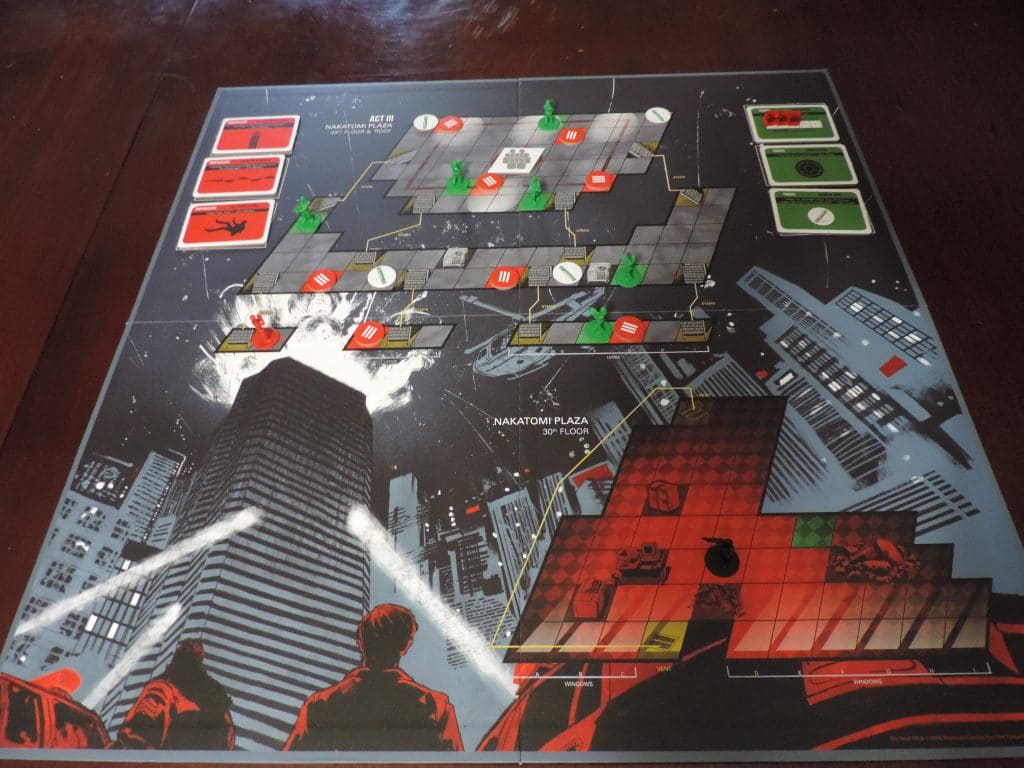Die Hard: The Nakatomi Heist is an example of excellence when it comes to IP (intellectual property) board games. Up to four players will assume the role of John McClane and Hans Gruber’s gang of thieves and pursue competing objectives:
- McClane is out to rescue the hostages and
- Put an end to Gruber’s scheme.
The Thieves aim to crack a series of six locks before blowing the roof off the building, granting them access to their $640 million payday; all while dealing with the pesky McClane.
What you know from the movie is brilliantly translated to the tabletop in what I think is the second best board game built around an IP ever. Calling it #2 may sound like a slight, but it isn’t at all. It’s just that the game I consider #1 in this regard goes the extra mile with their property compared to Nakatomi Heist (more on that below).
How to Play Die Hard: The Nakatomi Heist
The player controlling McClane will leverage a deck of Action cards that allow him to Move, Attack (Shoot or Punch), Shove, Sneak, Recover (return a discarded card to his hand), and gain Support from everyone’s favorite cop from the 80s: Reginald VelJohnson, aka Sergeant Powell.
His deck also serves as his health; a neat mechanic that declares him dead if he cannot draw three or more when he goes to refill his hand. This makes the Recover double as sort of healing.
In each of the three Acts, he’ll have three mandatory objectives he must complete before advancing. To do so, he has to navigate the board collecting tokens to round up the materials required to fulfill those objectives.

McClane’s player board and a glimpse at his cards. The board also has all instructions for his turn. ![]()
Objective tiles for Act 3.
The Thieves, on the other hand, will use their cards to progress through the series of locks and do their best to hinder McClane’s progress. Their card mechanic is pretty darned smart, too. There is a “master thief” that shows his card to the other two Thieves who then secretly give him a card each from their own hands.
The cards are then arranged in ascending numerical order. The two “outer” cards are used to cover up numbers on the current lock, while the card that ends up in the middle outlines the Actions the Thieves can take this turn.
The Thieves also have objectives in each Act. Those in the first two Acts are considered optional, but grant the Thieves bonus Lock actions which expedite their progress through the vault’s security. Those in the third Act are mandatory in order for the team to make off with the $640 million.
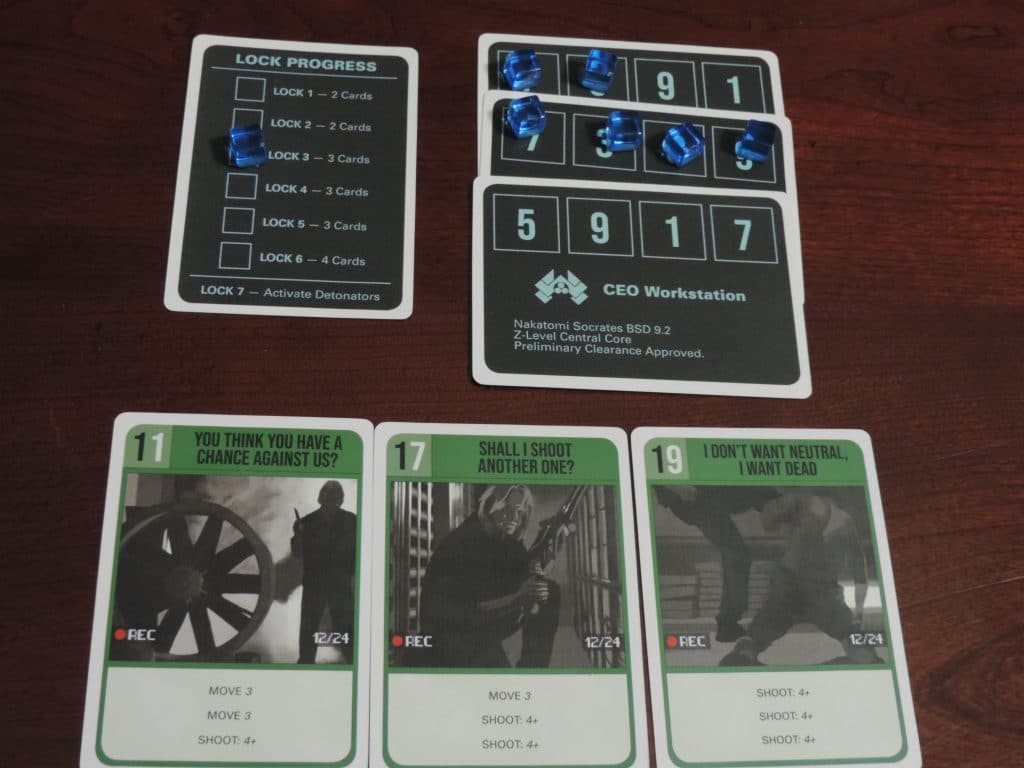
McClane wins if he manages to send Gruber out of the window before he dies or the Thieves blow the roof – with those two circumstances triggering a Thieves win.
Staking Our Claim on Die Hard: The Nakatomi Heist
 Components
Components
The cards are great and featured cell-shaded, black and white stills designed to look like they were taken from the security cameras of Nakatomi Plaza. They also feature little snippets of dialogue lifted straight outta the script. Extra fun can be had if you speak the quotes aloud as you play your cards!
The minis aren’t the most inspired ever, but they’re not bad. And the objectives and the various tokens that go with them are made of sturdy cardboard.
The real star here is the game board itself. It unfolds as you progress through the Acts with Act 1 on a single panel, Act 2 utilizing two, and Act 3 seeing the whole board unfurled.
Each Act also has true-to-the-movie obstacles and scenery; many of which are also tied directly to the various objectives for that particular Act. This might be the smartest, coolest game board I’ve ever seen.
 Luck
Luck
Luck comes in two primary flavors here:
There is, as with any card game, the luck of the draw. For both sides of the conflict, the cards will ultimately determine what you can do turn to turn, so even the best laid plans of the players can be delayed or entirely derailed by the cards in their hand.
Some of the actions also require the roll of a die: Shoot, Punch, Shove.
In addition, the means by which the Thieves select their three cards could also be said to feature a bit of luck, but it is manageable to a fair degree. While the cards they draw certainly affect what they can do, the cards they play can be managed well with a little thinking; even without communication.
 Aesthetics
Aesthetics
Die Hard: The Nakatomi Heist is a very gorgeous game. You’ll find yourself admiring the art that constitutes the background of each Act’s actual playing area.
Every component bleeds iconography from the movie; from the silhouettes of McClane, Gruber, and Theo (the hacker) on the card backs to the too-small shoes, fire hose, and broken glass of the objectives and tokens. It is all here, and it is all well done.
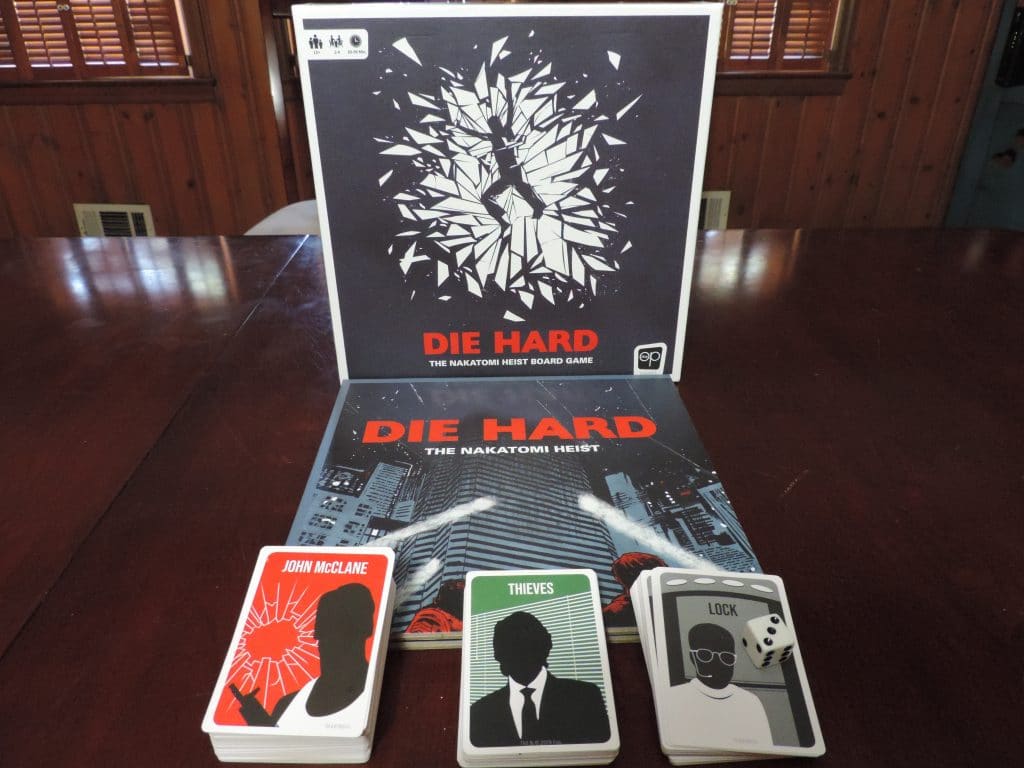
 Interest
Interest
We played with folks who can quote the movie without the aid of the cards and with at least one who, much to our shame, has not seen Die Hard. Fun was had by all!
I think it is fairly true of most IP-based games that familiarity with said IP definitely enhances the experiences quite a bit, but it isn’t required for a good ole time. The mechanics of this game hold up well apart from the movie tie-in.
That said: If you are a fan of the movie and you love tabletop gaming… this is a must own. It really is that good!
 Mood
Mood
There is a real sense of urgency to both sides of this game. McClane needs to move as quickly as possible through the Acts to limit the Thieves’s ability to crack locks. The longer he takes in Acts 1 and 2, the harder Act 3 becomes for him.
In one of our plays, the Thieves had all but one of the numbers on the last lock done when Act 3 started. That literally made it impossible for McClane to win; there was simply no way he could complete his objectives before we blew the roof.
And I genuinely dig that most of the primary objectives for both McClane and the Thieves don’t directly involve their opposing side, and when they do it is movie-appropriate. In each Act, McClane has to kill at least one Thief (once for the shoes, once for the body to throw out a window to alert Sergeant Powell, and once to finish off Gruber), but he can choose not to engage otherwise. This preserves the stealth option that McClane used so much in the movie.
Similarly: The Thieves die in a single shot from McClane, so while they’re not well suited to toe-to-toe confrontation, they can perform some excellent interference by babysitting tokens and guarding exits. In Act 2, they can even shoot out the glass partitions in the office to slow McClane down without engaging with him directly. Very cool!
Die Hard: The Nakatomi Heist is a fantastically designed and beautifully rendered board game that begs to be played over and over again. It is second in IP application only to The Thing: Infection at Outpost 31 in my opinion. The Thing does it so well, though, that I’m not sure if we’ll ever see a truer adaption of tone and mechanics from movie to tabletop.
And to say that this is the second best IP board game is not nothing (if you’ll forgive the double negative) given the sheer number of the things on the market.
Third place on this list is a distant third place.
Die Hard: The Nakatomi Heist would make an excellent addition to any gaming library. It is one of the best board games I’ve played this year–easily –and one that will see much more play in the days to come.
Welcome to the party, pal.


